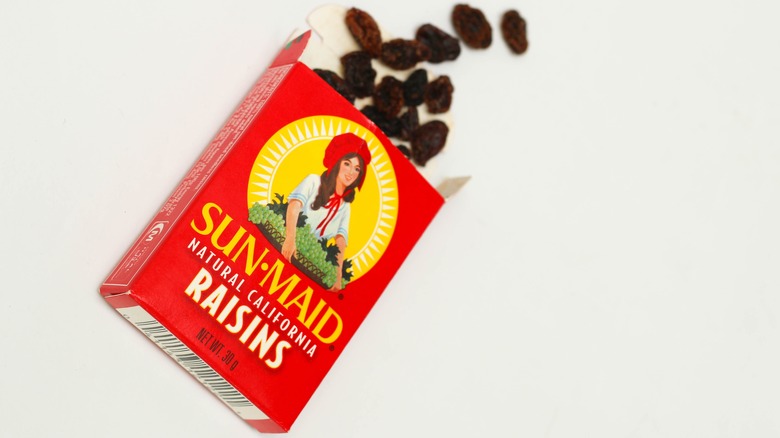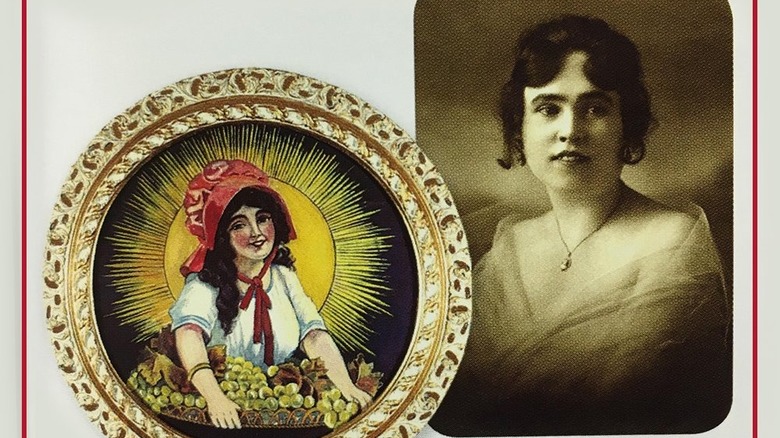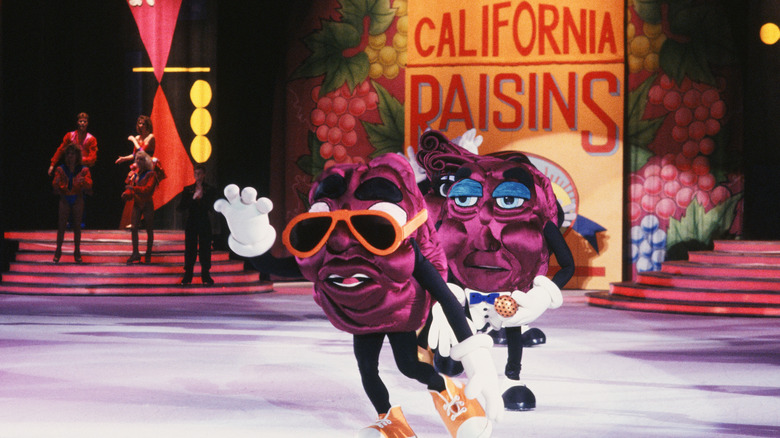The Simple Story Behind The Sun-Maid Raisin Mascot
The Sun-Maid Girl is one of the most iconic food mascots of all time. For many, one look at her brings old memories of eating raisins as a kid rushing back. The origins of raisins lie much further back in time than the childhood of anyone living today, though, with the practice dating back millennia to the Middle East (via Encyclopedia Britannica). Nowadays, however, the United States is one of the largest producers of raisins, with its dried grape industry concentrated in none other than sunny California.
The first raisin grapes in the Golden State were planted in the 1850s. Then, in 1912, the California Associated Raisin Company — a group of San Joaquin Valley growers — decided to band together and market their crops as one. That organization would later become the Sun-Maid Growers of California, a name inspired by advertiser E.A. Berg's efforts to help those farmers market the rural charm of their product. Yet, this brand lacked a mascot. Fortunately, it would find one, just a couple of years into its existence.
Lorraine Collett Petersen
It turns out the Sun-Maid Girl was a real person. As Sun-Maid explains, L.R. Payne, as company director, came across a young woman drying her hair in a bonnet and decided she was picture-perfect for their purposes. Sun-Maid's Japanese division gives more detail: Lorraine Collett Petersen was a 17-year-old girl working as a representative of Sun-Maid in May of 1915 at San Francisco's Panama-Pacific International Expo. There, she handed out samples while wearing a white blouse with blue piping and a blue sunbonnet. It wasn't until later, at her parents' home in Fresno, that Petersen changed into her mother's red bonnet and was spotted by Sun-Maid folks in her backyard. The wife of an executive (presumably Payne) suggested the red bonnet would be a good look for Sun-Maid since it matched the sun's shade. Petersen was given a basket of grapes to hold, and artist Fanny Scafford painted a watercolor that made its way onto packaging the next year.
Petersen was in possession of the original watercolor, which she gave to Sun-Maid in 1974 so that it could be stored in a vault at their headquarters. Similarly, she gifted the company the then faded-to-pink bonnet, which ended up in the Smithsonian Institute in Washington, D.C. in 1988. Prior to that, as noted by a New York Times obituary, Petersen had gone on to perform as an actress before running a restaurant and finally becoming a nurse. Still to this day, though, she remains the face of Sun-Maid.
California Raisins
Is there any raisin mascot more iconic than Sun-Maid Girl Lorraine Collett Petersen? The California Raisins may give her a run for her money. Back in the day, they were all the rage! The Raisin Advisory Board, which Sun-Maid was once part of, per the New York Times, unveiled these dry, dancing grapes in 1986, as documented by Food & Wine. The idea was to make raisins more popular and exciting, having failed to market them previously as nature's candy, for example. So, creatives took the beloved and serendipitously named song, "I Heard It Through the Grapevine," then recruited a pioneer of the up-and-coming claymation artform, and smashed it all together to personify raisins in a striking commercial (via YouTube).
Raisin sales increased and Sun-Maid profited. Celebrities like Ray Charles, Whoopi Goldberg, and the King of Pop tried to get in on the fun by appearing as raisins (Goldberg, unfortunately, didn't succeed there, while the others did). California Raisin TV specials were made. Albums were released by the Raisins. A shocking amount of merch was sold, even including a Nintendo videogame (via IGN), and performers dressed as the Raisins while touring around the United States, singing and dancing.
Yet, the California Raisin fad came and went. On the other hand, Sun-Maid's modern advertisements still include images of the maiden based upon Lorraine Collett Petersen. The California Raisins certainly were iconic, but the Sun-Maid Girl remains an absolute classic.


